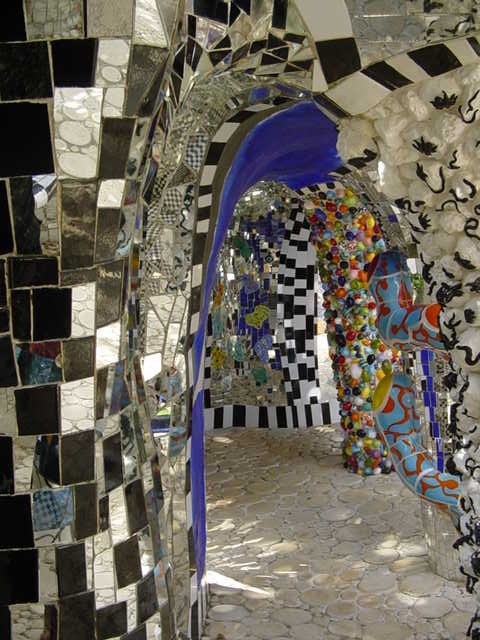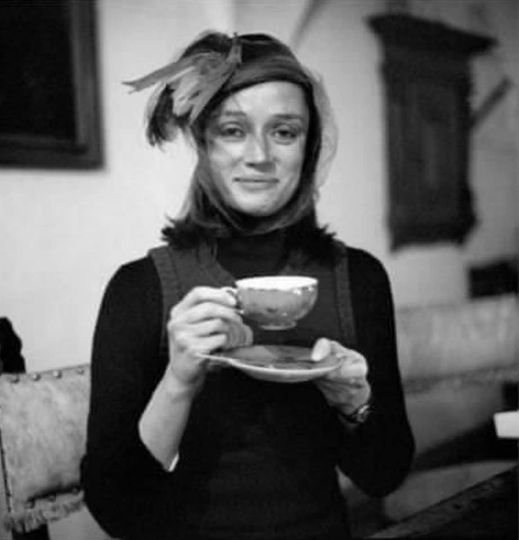THE TAROT GARDEN OF NIKI DE SAINT PHALLE
Please read the intro My Romance With Tarot
Along the Via Aurelia near the exit for Capalbio — there on the scrubby Maremma hillside, a kaleidoscopic flash of color–red, green, turquoise, yellow, hot pink, bedazzles your eyes. Further on, bizarre shapes pop out from the silvery blur of olive groves as you drive by: the pointy tip of a red rocket, a huge turquoise face with stairs spilling out of its gaping mouth, a giant rooster with a spikey cockscomb corona, a sparkly tower with a bicycle wreck on the top. It looks as though some psychedelic circus with crazy carnival rides has just set up camp on the hill. Instead, it’s a monumental sculpture garden, the major oeuvre of French American artist Niki de Saint Phalle (1930-2002) the Tarot Garden.

The Tarot Garden occupies a special place in Saint Phalle’s artistic journey. Construction first began on the project in 1979 when she was forty-nine years old, although the idea for the garden stretched all the way back to 1955. By the mid-nineteen seventies, she had already established herself as the architect of phantasmagoric, monumental sculptures, like Hon (1966), a pop art female body entered through parted thighs, housing a screening room, vending machine, and goldfish pond, weighing 6 tons, and measuring 23 meters in length or the Golem (1972), a scary climb-upon sculpture made for a children’s playground in Jerusalem.
The Tarot Garden took nearly twenty years to complete, opening to the public in 1998, when Saint Phalle was sixty-eight. Her second husband, Jean Tinguely, her artistic partner who had assisted her by welding the steel skeletons for all the structures and creating several pieces of his own for it, had already passed in 1991. Saint Phalle followed him in 2002.
The sculptures in the garden represent the twenty-two major arcana of the Tarot deck, viewed from Saint Phalle’s highly personal perspective formed over the arc of a lifetime. In the iconic figures of the Tarot cards, she found an itinerary of spiritual development, a guide to self-knowledge and wholeness. In this process, the reconciliation of male and female, the balancing of yin and yang within oneself was a primary goal. The Tarot Garden combines many influences, dreams, and visions that haunted the artist for decades and were expressed in various ways in her earlier works: her passion for fairy-tales and myths, children’s toys, monsters, explosive color, fanciful serpents, the Nanas – her signature sculptures of enormous, sassy, buxom female figures representing joy and liberation; and the idea of creating a town where women rule – Nana Town.
Niki de Saint Phalle’s Early Life & Influences
Daughter of a French aristocrat and an American heiress, Niki de Saint Phalle was born Catherine Marie-Agnès Fal de Saint-Phalle in Neuilly-sur-Seine, France. Shortly after her birth, her parents emigrated to the United States, in the early phase of the Great Depression, leaving Niki with her grandmother in a chateau. The grandiose chateau, its stonework, secret places, coats-of-arms, and heraldic symbols made a powerful impression on her, further enhanced through the years by the stories her grandparents told her: fairy-tales, legends of knights and ladies, and the illustrious history of her ancestors. It was an environment presided over by a nurturing mother figure – her grandmother — and an enchanted place where fantasy may become real. Her hunger for magic places outside time would become a driving force in her artistic development.
At the age of three, she joined her parents in New York City, where they had settled in Manhattan on the Upper East Side. Her father helped finance what soon became the most famous restaurant in the city: Le Pavilion, where they often dined. Her mother made sure her children benefited from the city’s many cultural opportunities – museums on Sunday, where the Egyptian exhibits of the Metropolitan Museum captivated Niki; ice-skating at Rockefeller Center in the winter; summers in Connecticut or Long Island; visits to France and the family chateau.
Though this might sound ideal, Niki’s childhood and adolescence were turbulent and traumatic. Both parents were abusive. Her mother beat the children and once forced her brother to eat his own vomit. Niki’s father molested her sexually from the age of eleven on, as she would later confess in her memoir: Mon Secret. Despite all, Niki adored her sophisticated, elegant mother, and craved her good opinion, rarely granted. As an adult, Saint Phalle believed that this was the key to her success as an artist. Learning to survive emotionally without her mother’s approval made her independent and free from the judgements of others. She also resolved that she would never become her mother: counting linens in a cupboard, and obsessed with housekeeping.
Rebellious and mischievous, she did poorly at school. Strikingly beautiful, she found work as a fashion model at the age of seventeen and at eighteen escaped her nightmarish family by eloping with the writer-musician Harry Matthews. Matthews, just a year older than Niki, came from a wealthy family gravitating in the Saint Phalles’ elite circle.
The young couple adopted a Bohemian lifestyle on a shoestring budget, as Matthews’ disapproving parents withdrew their economic support. The newlyweds would sometimes shoplift books or luxury food items they couldn’t afford to buy. Niki was only twenty-one when her first child was born. Housewifely and maternal duties weighed heavy on her. Unable to deal with laundry, she just hid dirty clothes under the bed, and thought nothing of leaving their infant daughter alone at home while they went out in the evenings.
When Matthews inherited money, the couple moved to Paris, bouncing about Europe, mingling with writers, musicians, and artists. Niki took up painting and wanted to study acting. Then while in Nice, they became sexually involved with another couple: Harry with the wife and Niki with the husband: a French veteran obsessed with suicide.
The entanglement à quatre proved very stressful, leading Saint Phalle to a major breakdown during which she attacked her husband’s lover and attempted suicide. Later discovering a collection of razors and knives Saint Phalle had hidden under a mattress, Harry had her interned in an asylum in Nice.
“Why are there bars on the windows?” she asked Harry, who replied “To catch butterflies.”
“I believed him.” – she later wrote. Her treatment involved ten rounds of electroshock therapy. The doctors told Matthews that it could take up to five years for her to be cured. She sometimes dreamed of rats gnawing her body but she also dreamed about a magic garden, and that dream sustained her during her stay.
